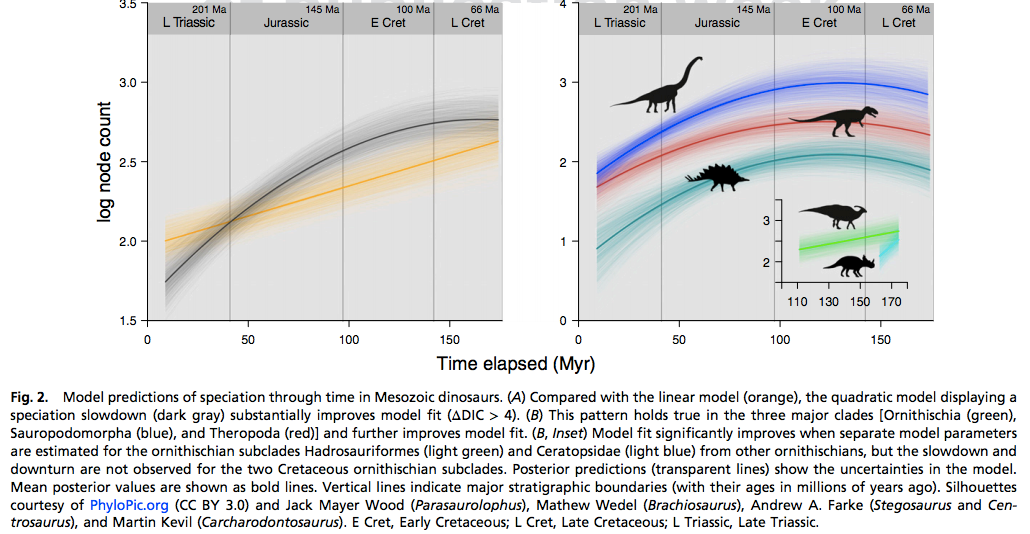Scientists believe that dinosaurs were doomed to extinction and without the fall of the asteroid
About 66 million years ago, a giant asteroid fell on the Yucatan Peninsula, resulting in the release of large amounts of soot and carbon monoxide into the atmosphere, causing extreme climate change, which destroyed most of the dinosaurs. However, this is not the whole story. A new study by a group of scientists from the UK shows that most dinosaurs were on the verge of extinction before the fall of Chicxulub , which changed the Earth’s ecosystem forever, reports arstechnica .
Scientists were interested in two parameters - the rate of appearance of new species and the rate of extinction of already existing dinosaurs. If the first figure exceeds the second, then we can say that dinosaurs flourished and expanded their presence on Earth, and in the reverse situation we are talking about their slow extinction.
The researchers published their findings in the journal PNAS . They found that the dinosaur population had decreased even before the asteroid had fallen on our planet. The study shows that the number of dinosaurs of the three main sub- orders - the bird - catching , cave-growing morphs and theropods began to fall. This is indicated by calculations of the rate of extinction and the emergence of new species. Simply put, new dinosaur species did not evolve to replace those that became extinct.

')
“All available evidence indicates that dinosaurs, which at that time existed and dominated terrestrial ecosystems for more than 150 million years, somehow lost the ability to quickly form new species. Most likely, this was one of the reasons why they could not survive the environmental crisis caused by the fall of the asteroid, ”said Michael Benton, one of the scientists who conducted the study.
Scientists have come to this conclusion by building the so-called “tree of extinction” of various species, genera and families of dinosaurs who lived in the last few million years before the catastrophe. For this, over 600 different dinosaur species were distributed and compared.
This “gradual decline” scenario suggests that the Chicxulub disaster was not so much the cause of the extinction of dinosaurs, as the last fatal blow to an already weakened group of animals.
The truth is that mass extinction is always a long and chaotic process. The standard definition for mass extinction, when 75 percent or more of Earth’s species is dying out, has a caveat: this process usually takes more than a million years. In fact, it is phenomenally difficult to kill so many species. The Earth itself, with its tectonic shifts, killed dinosaurs long before the asteroid fell, which simply completed the work begun.
Scientists were interested in two parameters - the rate of appearance of new species and the rate of extinction of already existing dinosaurs. If the first figure exceeds the second, then we can say that dinosaurs flourished and expanded their presence on Earth, and in the reverse situation we are talking about their slow extinction.
The researchers published their findings in the journal PNAS . They found that the dinosaur population had decreased even before the asteroid had fallen on our planet. The study shows that the number of dinosaurs of the three main sub- orders - the bird - catching , cave-growing morphs and theropods began to fall. This is indicated by calculations of the rate of extinction and the emergence of new species. Simply put, new dinosaur species did not evolve to replace those that became extinct.

')
“All available evidence indicates that dinosaurs, which at that time existed and dominated terrestrial ecosystems for more than 150 million years, somehow lost the ability to quickly form new species. Most likely, this was one of the reasons why they could not survive the environmental crisis caused by the fall of the asteroid, ”said Michael Benton, one of the scientists who conducted the study.
Scientists have come to this conclusion by building the so-called “tree of extinction” of various species, genera and families of dinosaurs who lived in the last few million years before the catastrophe. For this, over 600 different dinosaur species were distributed and compared.
This “gradual decline” scenario suggests that the Chicxulub disaster was not so much the cause of the extinction of dinosaurs, as the last fatal blow to an already weakened group of animals.
The truth is that mass extinction is always a long and chaotic process. The standard definition for mass extinction, when 75 percent or more of Earth’s species is dying out, has a caveat: this process usually takes more than a million years. In fact, it is phenomenally difficult to kill so many species. The Earth itself, with its tectonic shifts, killed dinosaurs long before the asteroid fell, which simply completed the work begun.
Source: https://habr.com/ru/post/372121/
All Articles